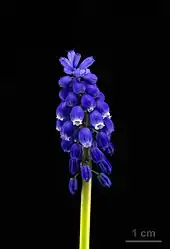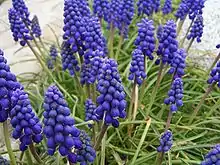Muscari armeniacum
Muscari armeniacum is a species of flowering plant in the squill subfamily Scilloideae of the asparagus family Asparagaceae (formerly the lilies, Liliaceae). It is a bulbous perennial with basal, simple leaves and short flowering stems. It is one of a number of species and genera known as grape hyacinth, in this case Armenian grape hyacinth[1] or garden grape-hyacinth.[2] The flowers are purple, blue (with a white fringe), white (cv. ‘Album’) or pale pink (cv. ‘Pink Sunrise’) and the plants are usually 15 centimetres (6 in) tall. M. armeniacum blooms in mid-Spring (April or May in the Northern Hemisphere) for 3–4 weeks. Some selections are fragrant. Established bulbs leaf in the autumn. M. armeniacum is widespread in the woods and meadows of the Eastern Mediterranean, from Greece and Turkey to the Caucasus,[3] including Armenia which gives it its name.

| Muscari armeniacum | |
|---|---|
 | |
| Flowering plants | |
| Scientific classification | |
| Kingdom: | Plantae |
| Clade: | Tracheophytes |
| Clade: | Angiosperms |
| Clade: | Monocots |
| Order: | Asparagales |
| Family: | Asparagaceae |
| Subfamily: | Scilloideae |
| Genus: | Muscari |
| Species: | M. armeniacum |
| Binomial name | |
| Muscari armeniacum Leichtlin | |
Cultivation
Muscari armeniacum is one of the most commonly cultivated species of Muscari, is robust and naturalises easily.[4] It appeared in European gardens in 1871.[5] The following have gained the Royal Horticultural Society’s Award of Garden Merit:[6]
Cultivars listed by Mathew include 'Blue Spike' and 'Cantab'.[4] Others include 'Argaei Album' and 'Album' (white), 'Côte d'Azur', 'Dark Eyes, 'Early Giant', 'Fantasy Creation', 'Peppermint', 'Saffier', 'Valerie Finnis' (pale blue), and 'Pink Sunrise' (pale pink). The commonly available form is often referred to as M. armeniacum 'Blue'.[11][12]
'Blue Spike' is a double flowered variety, with double florets on the flower stalk.[13] 'Cantab' is pale blue. 'Fantasy Creation' is a sport (a naturally occurring genetic mutation) of 'Blue Spike'. [14] 'Atlantic' is light blue, introduced by Jan van Bentem in 2002, by hybridisation in 1990 from M. armeniacum and an unknown parent.[15]
Gallery

 Bell-shaped flowers of a Muscari armeniacum surrounded by leaves of Hosta 'Undulata', Munich Botanical Garden, Germany
Bell-shaped flowers of a Muscari armeniacum surrounded by leaves of Hosta 'Undulata', Munich Botanical Garden, Germany Immature capsules of Muscari armeniacum 'Peppermint', Gothenburg Botanical Garden, Sweden
Immature capsules of Muscari armeniacum 'Peppermint', Gothenburg Botanical Garden, Sweden
References
- Grey-Wilson, Christopher; Mathew, Brian & Blamey, Marjorie (1981), Bulbs : the bulbous plants of Europe and their allies, London: Collins, ISBN 978-0-00-219211-8, p. 115
- "BSBI List 2007". Botanical Society of Britain and Ireland. Archived from the original (xls) on 2015-01-25. Retrieved 2014-10-17.
- "Muscari". Pacific Bulb Society. 2013-04-24. Retrieved 2013-10-03.
- Mathew, Brian (1987), The Smaller Bulbs, London: B.T. Batsford, ISBN 978-0-7134-4922-8, pp. 126
- "Paghat's Garden: Armenian Grape Hyacinth". Paghat.com. Retrieved 2013-10-03.
- "AGM Plants - Ornamental" (PDF). Royal Horticultural Society. July 2017. p. 65. Retrieved 9 April 2018.
- "RHS Plantfinder - Muscari armeniacum". Retrieved 9 April 2018.
- "RHS Plantfinder - Muscari armeniacum 'Christmas Pearl'". Retrieved 9 April 2018.
- "RHS Plantfinder - Muscari armeniacum 'Jenny Robinson'". Retrieved 9 April 2018.
- "RHS Plantfinder - Muscari armeniacum 'Saffier'". Retrieved 9 April 2018.
- "The Plant Expert: Muscari". Archived from the original on 2009-11-25. Retrieved 2010-10-24.
- "Pacific Bulb Society". Pacific Bulb Society. 2013-04-24. Retrieved 2013-10-03.
- "Northern Shade Gardening: Blue Muscari". Northernshade.ca. Retrieved 2013-10-03.
- "Martin Philippo: Muscaripages - Fantasy Creation". Home.tiscali.nl. Archived from the original on 2011-06-14. Retrieved 2013-10-03.
- "Muscari armeniacum "Atlantic'". Archived from the original on 2009-08-14.
Sources
- Taylor's guide to Bulbs. Houghton Miflin Boston 1986. p. 350. ISBN 0-395-40449-5
External links
| Wikimedia Commons has media related to Muscari armeniacum. |
- North Carolina State University: Muscari armeniacum
- Beth Hanson, Editor (1 November 2002). Spring-Blooming Bulbs: An A to Z Guide to Classic and Unusual Bulbs for Your Spring Garden. Brooklyn Botanic Garden. p. 86. ISBN 978-1-889538-54-9. Retrieved 24 November 2012.